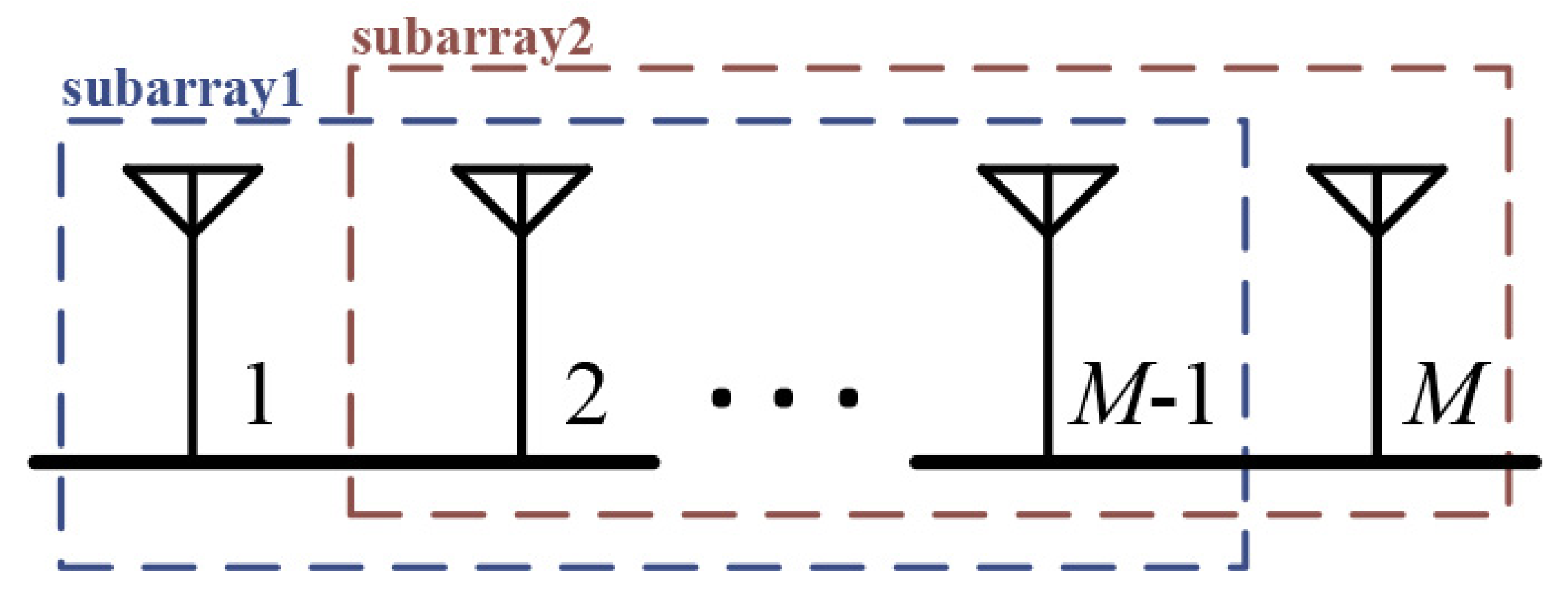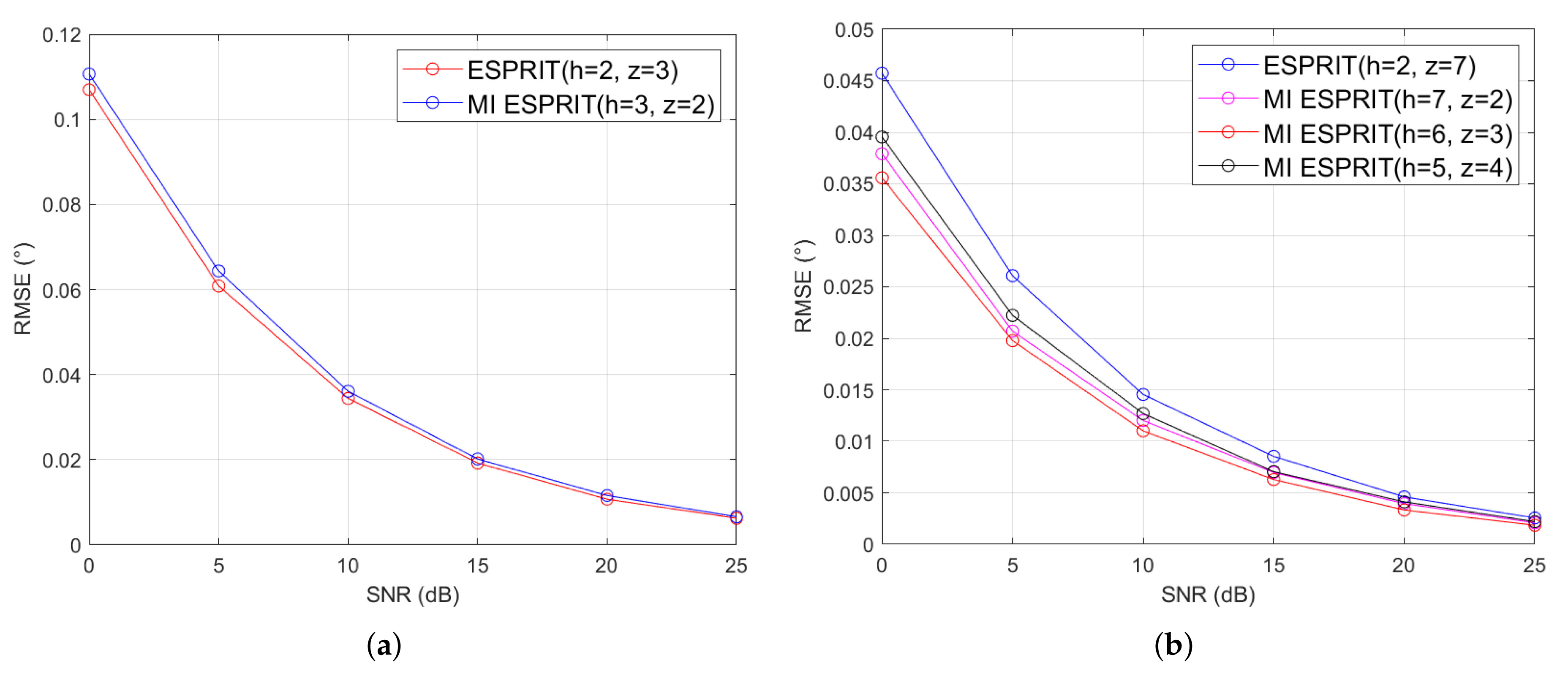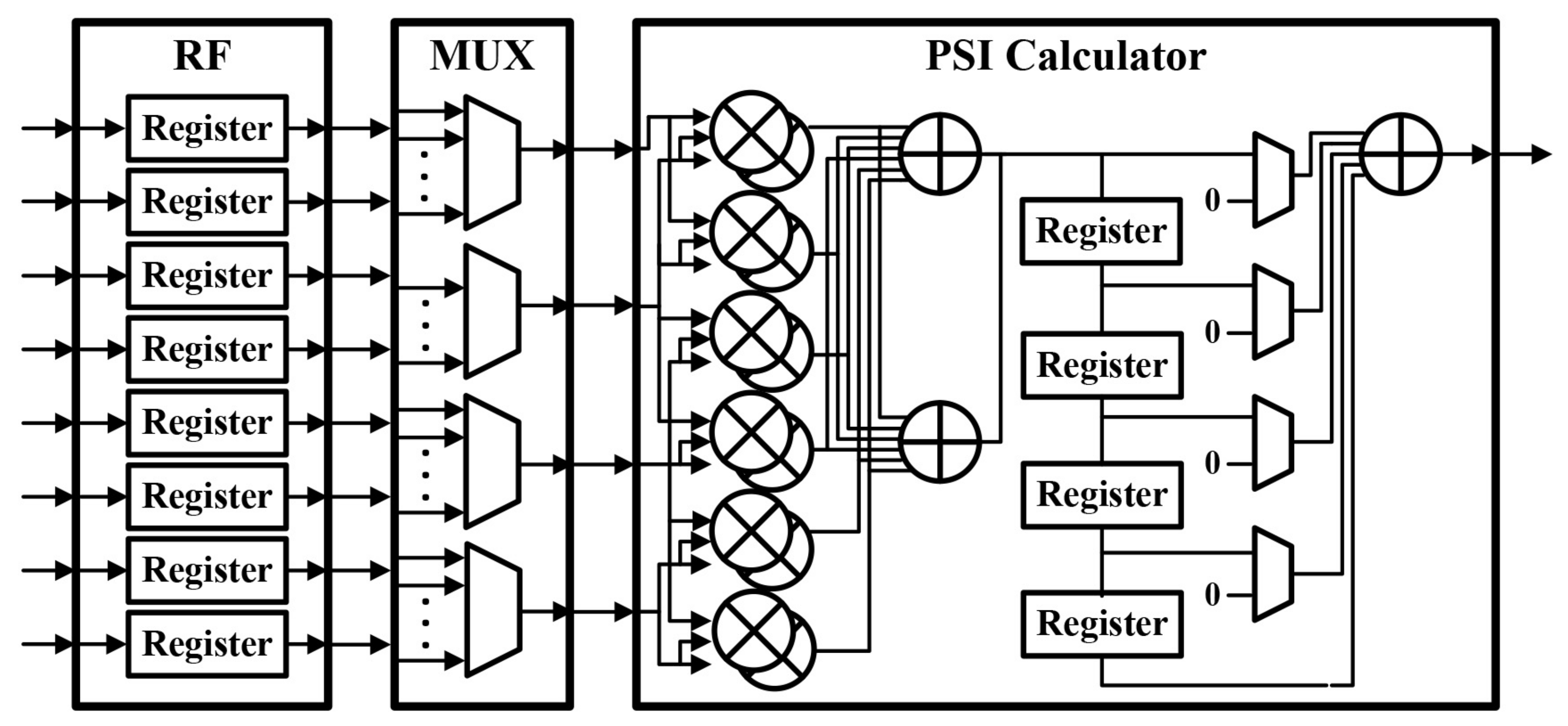Scalable ESPRIT Processor for Direction-of-Arrival Estimation of Frequency Modulated Continuous Wave Radar
Abstract
:1. Introduction
2. ESPRIT Algorithm for Estimating DOA
2.1. Signal Model
2.2. ESPRIT and MI-ESPRIT Algorithm
2.3. DOA Estimation Technique for Single Target
2.4. Comparison of RMSE Performance According to the Number of Antennas
3. Hardware Architecture of Proposed ESPRIT Processor
3.1. Covariance Matrix Module (CMM)
3.2. Eigenvalue Decomposition Module (EDM)
3.3. Least Square Module (LSM)
3.4. Angle Estimation Module (AEM)
4. Implementation Results of Proposed ESPRIT Processor
5. Conclusions
Author Contributions
Funding
Conflicts of Interest
References
- You, G.H.; Qiu, T.S.; Yang, J. A novel DOA estimation algorithm of cyclostationary signal based on UCA in impulsive noise. AEU Int. J. Electron. Commun. 2013, 67, 491–499. [Google Scholar] [CrossRef]
- Luo, J.; Zhang, G.; Yu, K. An automatically paired two-dimensional direction-of-arrival estimation method for two parallel uniform linear arrays. AEU Int. J. Electron. Commun. 2017, 72, 46–51. [Google Scholar] [CrossRef]
- Li, J.; Jiang, D.; Zhang, X. DOA estimation based on combined unitary ESPRIT for coprime MIMO radar. IEEE Commun. Lett. 2016, 21, 96–99. [Google Scholar] [CrossRef]
- Gu, Y.; Zhang, Y.D.; Goodman, N.A. Optimized compressive sensing-based direction-of-arrival estimation in massive MIMO. In Proceedings of the IEEE International Conference on Acoustics, Speech and Signal Processing (ICASSP), New Orleans, LA, USA, 5–9 March 2017; pp. 3181–3185. [Google Scholar]
- Schmidt, R. Multiple emitter location and signal parameter estimation. IEEE Trans. Antennas Propag. 1986, 34, 276–280. [Google Scholar] [CrossRef] [Green Version]
- Roy, R.; Kailath, T. ESPRIT-estimation of signal parameters via rotational invariance techniques. IEEE Trans. Acoust. Speech Signal Process. 1989, 37, 984–995. [Google Scholar] [CrossRef] [Green Version]
- Cui, L.; Zhang, Y.; Jiao, Y. Two-dimensional MUSIC Spectral Peak Search Algorithm Based on Improved Chicken Swarm Optimization. In Proceedings of the 2019 IEEE International Conference on Signal Processing, Communications and Computing (ICSPCC), Dalian, China, 20–22 September 2019; pp. 1–5. [Google Scholar]
- Li, W.; Liao, W.; Fannjiang, A. Super-resolution limit of the ESPRIT algorithm. IEEE Trans. Inf. Theory 2020, 66, 4593–4608. [Google Scholar] [CrossRef]
- Steinw, T.J.; Roemer, F.; Haardt, M. Second-order performance analysis of Standard ESPRIT. In Proceedings of the 2017 IEEE International Conference on Acoustics, Speech and Signal Processing (ICASSP), New Orleans, LA, USA, 5–9 March 2017; pp. 3051–3055. [Google Scholar]
- Roy, R.; Paulraj, A.; Kailath, T. ESPRIT—A subspace rotation approach to signal parameter estimation. IEEE Trans. Acoust. Speech Signal Process. 1986, 34, 1340–1342. [Google Scholar] [CrossRef]
- Baig, N.A.; Malik, M.B. Comparison of direction of arrival (DOA) estimation techniques for closely spaced targets. Int. J. Future Comput. Commun. 2013, 2, 654–659. [Google Scholar] [CrossRef]
- Zhou, L.; Haung, D.; Duan, H.; Chen, Y. A modified ESPRIT algorithm based on a new SVD method for coherent signals. In Proceedings of the 2011 IEEE International Conference on Information and Automation, Shenzhen, China, 6–8 June 2011; pp. 75–78. [Google Scholar]
- Gupta, P.; Verma, V.K.; Senapati, V. Angle of arrival detection by ESPRIT method. In Proceedings of the 2017 International Conference on Communication and Signal Processing (ICCSP), Chennai, India, 6–8 April 2017; pp. 1143–1147. [Google Scholar]
- Dhope, T.S. Application of MUSIC, ESPRIT and Root MUSIC in DOA estimation. World J. Sci. Technol. 2011, 1, 20–25. [Google Scholar]
- Oumar, O.A.; Siyau, M.F.; Sattar, T.P. Comparison between MUSIC and ESPRIT direction of arrival estimation algorithms for wireless communication systems. In Proceedings of the The First International Conference on Future Generation Communication Technologies, London, UK, 12–14 December 2012; pp. 99–103. [Google Scholar]
- Zhang, X.; Gao, X.; Xu, D. Multi-invariance ESPRIT-based blind DOA estimation for MC-CDMA with an antenna array. IEEE Trans. Veh. Technol. 2009, 58, 4686–4690. [Google Scholar] [CrossRef]
- Xu, Y.; Liu, Z. Closed-form multiple invariance ESPRIT. Multidimens. Syst. Signal Process. 2007, 18, 47–54. [Google Scholar] [CrossRef]
- Alhamed, A.; Tayem, N.; Alshawi, T.; Alshebeili, S.; Alsuwailem, A.; Hussain, A. FPGA-based real-time implementation for direction-of-arrival estimation. J. Eng. 2017, 6, 260–265. [Google Scholar] [CrossRef]
- Hussain, A.A.; Tayem, N.; Butt, M.O.; Soliman, A.H.; Alhamed, A.; Alshebeili, S. FPGA hardware implementation of DOA estimation algorithm employing LU decomposition. IEEE Access 2018, 6, 17666–17680. [Google Scholar] [CrossRef]
- Guenther, D.; Leupers, R.; Ascheid, G. A Scalable, Multimode SVD precoding ASIC based on the Cyclic Jacobi Method. IEEE Trans. Circuit Syst. Regul. Pap. 2016, 63, 1283–1294. [Google Scholar] [CrossRef]
- Alessandrini, M.; Biagetti, G.; Crippa, P.; Falaschetti, L.; Manoni, L.; Turchetti, C. Singular Value Decomposition in Embedded Systems Based on ARM Cortex-M Architecture. Electronics 2021, 10, 34. [Google Scholar] [CrossRef]
- Cui, K.; Wu, W.; Huang, J.; Chen, X.; Yuan, N. DOA estimation of LFM signals based on STFT and multiple invariance ESPRIT. AEU Int. J. Electron. Commun. 2017, 77, 10–17. [Google Scholar] [CrossRef]
- Lin, J.; Ma, X.; Yan, S.; Hao, C. Time-frequency multi-invariance ESPRIT for DOA estimation. IEEE Antennas Wirel. Propag. Lett. 2015, 15, 770–773. [Google Scholar] [CrossRef]
- Hyun, E.; Lee, J. Moving target range detection algorithm for FMCW radar. In Proceedings of the 2013 14th International Radar Symposium (IRS), Dresden, Germany, 19–21 June 2013; pp. 758–761. [Google Scholar]
- Dzvonkovskaya, A.L.; Rohling, H. CFAR target detection based on gumbel distribution for HF radar. In Proceedings of the 2006 International Radar Symposium, Krakow, Poland, 24–26 May 2006; pp. 1–4. [Google Scholar]
- Tang, T.; Wu, C.; Elangage, J. Analyze the FMCW Waveform Skin Return of Moving Objects in the Presence of Stationary Hidden Objects using Numerical Models. Electronics 2021, 10, 28. [Google Scholar] [CrossRef]
- Park, G.H.; Seo, Y.K.; Kim, H.N. Range-Doppler Domain-Based DOA Estimation Method for FM-Band Passive Bistatic Radar. IEEE Access 2020, 8, 56880–56891. [Google Scholar] [CrossRef]
- Shahshahani, S.M.R.; Mahdiani, H.R. A High-Performance Scalable Shared-Memory SVD Processor Architecture Based on Jacobi Algorithm and Batcher’s Sorting Network. IEEE Trans. Circuit Syst. Regul. Pap. 2020, 67, 1912–1924. [Google Scholar] [CrossRef]
- UltraSclae+ ZCU104 Overview. Available online: https://www.xilinx.com/products/boards-and-kits/zcu104.html#overview (accessed on 20 February 2021).
- Hussain, A.A.; Tayem, N.; Soliman, A.H.; Radaydeh, R.M. FPGA hardware implementation of Computationally Efficient Multi-Source DOA Estimation Algorithms. IEEE Access 2019, 7, 88845–88858. [Google Scholar] [CrossRef]
- Abusultan, M.; Harkness, S.; LaMeres, B.J.; Huang, Y. FPGA implementation of a Bartlett direction of arrival algorithm for a 5.8ghz circular antenna array. In Proceedings of the 2010 Aerospace Conference, Big Sky, MT, USA, 6–13 March 2010; pp. 1–10. [Google Scholar]












| Number of Antenna | 2 | 3 | 4 | 5 | 6 | 7 | 8 | |
|---|---|---|---|---|---|---|---|---|
| Cycle | Conventional | 48 | 150 | 300 | 520 | 780 | 1134 | 1512 |
| Proposed | 48 | 100 | 150 | 208 | 260 | 324 | 378 | |
| Reduction (%) | 0 | 33 | 50 | 60 | 66 | 71 | 75 | |
| Parameter | Value | |
|---|---|---|
| Target FPGA | Xilinx UltraSclae+ ZCU104 | |
| Maximum Operating Frequency | 334 MHz | |
| LUT | 28,978 | |
| FF | 11,279 | |
| DSP | 374 | |
| Execution Time (s) | = 2 | 0.39 |
| = 3 | 0.53 | |
| = 4 | 0.67 | |
| = 5 | 0.79 | |
| = 6 | 0.99 | |
| = 7 | 1.48 | |
| = 8 | 1.86 | |
| [18] | [19] | [30] | [31] | Proposed | ||
|---|---|---|---|---|---|---|
| Algorithm | ESPRIT | ESPRIT | Cholesky | Bartlett | MI-ESPRIT | |
| Number of Antenna | 4 | 4 | 4 | 8 | 2–8 | |
| Word Length | 16 | 16 | 16 | 16 | 16 | |
| Target FPGA | Virtex-5 | Virtex-5 | Virtex-5 | Virtex-5 | Virtex-5 | |
| Maximum Operating Frequency (MHz) | 52.5 | 62.99 | 63.0 | N.A. | 120 | |
| Slice Registers | 35,331 | 16,710 | 17,362 | 10,399 | 10,088 | |
| LUT | 40,019 | 22,936 | 21,956 | 7,617 | 18,207 | |
| DSP | 253 | 240 | 230 | N.A. | 80 | |
| Execution Time (s) | 24.38 | 2.49 | 3.08 | 46.34 | 1.87 | |
| Processing Rate (Hz) | 41,017 | 401,606 | 324,675 | 21,580 | 535,714 | |
| Area Efficiency | Hz/Registers | 1.16 | 24.03 | 18.70 | 2.075 | 53.10 |
| Hz/LUT | 1.02 | 17.51 | 14.79 | 2.83 | 29.42 | |
Publisher’s Note: MDPI stays neutral with regard to jurisdictional claims in published maps and institutional affiliations. |
© 2021 by the authors. Licensee MDPI, Basel, Switzerland. This article is an open access article distributed under the terms and conditions of the Creative Commons Attribution (CC BY) license (http://creativecommons.org/licenses/by/4.0/).
Share and Cite
Jung, Y.; Jeon, H.; Lee, S.; Jung, Y. Scalable ESPRIT Processor for Direction-of-Arrival Estimation of Frequency Modulated Continuous Wave Radar. Electronics 2021, 10, 695. https://doi.org/10.3390/electronics10060695
Jung Y, Jeon H, Lee S, Jung Y. Scalable ESPRIT Processor for Direction-of-Arrival Estimation of Frequency Modulated Continuous Wave Radar. Electronics. 2021; 10(6):695. https://doi.org/10.3390/electronics10060695
Chicago/Turabian StyleJung, Yongchul, Hohyub Jeon, Seongjoo Lee, and Yunho Jung. 2021. "Scalable ESPRIT Processor for Direction-of-Arrival Estimation of Frequency Modulated Continuous Wave Radar" Electronics 10, no. 6: 695. https://doi.org/10.3390/electronics10060695







